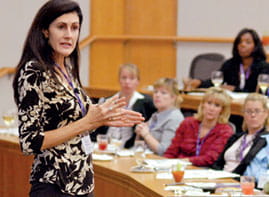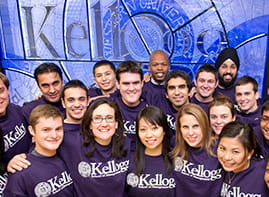Economic downturn highlights importance of a good plan, says Kellogg professor spearheading the Jan. 7 Kellogg Strategy Challenge, a new experiential learning initiative
12/30/2008 - More than 600 first-year Kellogg students have competed in the school’s inaugural Strategy Challenge, an initiative designed to bring analytical rigor to bear on the business problems that practitioners face. Now, only 40 finalists remain.
 |
| Prof. Thomas Hubbard |
| Photo © Evanston Photographic |
The contest, which began with a preliminary round in December, culminates Jan. 7 as a narrowed field of nine student teams presents strategic proposals before a panel of judges at the James L. Allen Center in Evanston. Judges include senior Kellogg faculty and alumni strategy experts. To advance to the final round, each team had to prepare a 12-20-page analysis of strategic issues surrounding the discount apparel retailer Steve & Barry’s.
The Kellogg Strategy Challenge (KSC) is a new way to bridge classroom lessons and the real-world situations that students will confront after graduation. As such, the event has been built into the school’s core Management and Strategy course that all students must take during the first quarter of their first year while enrolled at Kellogg.
Among those leading the KSC is Thomas Hubbard, the John L. and Helen Kellogg Professor of Management and Strategy. An expert in strategy and the economics of organizations, Professor Hubbard has been published widely in top-ranked journals. He is co-editor of the Journal of Industrial Economics and a faculty research fellow at the National Bureau of Economic Research. Professor Hubbard provided additional insight into the new experiential learning initiative and also explained why some firms fail to get a handle on their strategy.
Matt Golosinski: The Strategy Challenge seems a fine way to tap into the traditional Kellogg “team culture.” At the same time, the event clearly spurs the competitive spirit that is so prominent in real-world business success. As one of the faculty members leading this contest, what were your objectives when designing the case and the challenge’s overall format?
Professor Thomas Hubbard: The main expectations and objectives for this are the same as our expectations and objectives for the core strategy course: to develop students who can apply analytical concepts from economics to real-world strategy issues in a rigorous, well-grounded way. The entire course is designed to do this. We developed the Strategy Challenge with the hope of reinforcing connections among students, faculty and thought leaders in strategy, and thought that it would be appropriate and productive for Kellogg to have the hub of these connections be based on an event that showcases what each of these groups has to offer each other in the form of intellectual output.
MG: As I understand it, the core Management and Strategy course has traditionally required students to produce a final project. What’s different about this year that has resulted in turning this requirement into a major event?
Prof. Hubbard: This actually is not true. Not all sections did [have to complete a project]; in fact, while my sections in the past have had group projects, these were not final projects. The main thing that is different this year is that the nine sections of the course are more closely coordinated with each other. One element of this was to have a common final project that all professors teaching the course assigned their students. Once we did this, there was an opportunity to create the KSC, which we anticipate will be an annual event that is the course capstone and the hub of connections between students, faculty and thought leaders in the strategy community.
MG: How have students responded to this initiative?
Prof. Hubbard: My sense is that as students have begun to understand that this would be an event unlike the other various "competitions" sponsored by student groups or outside firms, they started to become intrigued and excited.
MG: What can you tell us about the centerpiece of the KSC itself, the case study? What is the crux of the strategic issue that the finalists are grappling with?
Prof. Hubbard: The case is about the strategic challenges faced by Steve & Barry's, a low-end apparel retailer, over the past five years or so. Steve & Barry’s started by selling college-licensed apparel and other inexpensive clothes near large colleges, undercutting campus bookstores by 50 percent or more on price. A few years ago, it changed its strategy, putting stores in low-end shopping malls and extending its product line to include celebrity-branded lines such as Stephon Marbury's "Starbury" shoes and Sarah Jessica Parker's "Bitten" line of cheap chic women's apparel. The company then struggled, went into bankruptcy and the recent economic downturn led the firm to go out of business.
Students are asked to assess Steve & Barry's strategy at various points in time in light of the analytical concepts taught in the core business strategy class, and then propose changes to that strategy based on their analysis.
MG: How does a competition like this benefit a student? What can you say about the intersection of classroom study and experiential learning opportunities such as the Kellogg Strategy Challenge?
Prof. Hubbard: It gives the students a chance to react to each others' work. In the challenge’s first round, students presented to other members of their class sections. The challenge itself on Jan. 7 provides students, faculty and thought leaders a common context in which to promote and exchange ideas. This is an important function that universities play broadly — they are institutions in which intellectual capital is developed and they provide a forum for the exchange and refinement of ideas among students, faculty and the external community. The Kellogg Strategy Challenge is a platform for this.
MG: What are the kinds of skills that the winning team is likely to bring to bear on the case? What mix of strengths is more likely to result in a winning combination when it comes to solving a case like this?
Prof. Hubbard: They face different levels of challenges, as they do throughout the core strategy course. They have to be able to internalize and control the relevant analytical frameworks. They have to take an ambiguous and often messy real-world situation and boil it down to its most important elements. They have to figure out which analytical frameworks are particularly useful for examining these elements. They have to execute this analysis. And they have to communicate all of this clearly to others. The most successful students with respect to this set of tasks tend to be those that bring insight that allows them to see the how the big and smaller pictures fit together, and who have internalized the analytic frameworks sufficiently well so that they can apply them in a natural way.
MG: Who is judging this competition and what do they bring to the experience? It seems that having judges present immediately elevates the tone, making the event more serious for everyone involved.
Prof. Hubbard: The judges are thought leaders in strategy from consulting firms and academia. We thought it important to attract very high-level people from the outside because they are both consumers of the intellectual output of Kellogg students and faculty, and because Kellogg students and faculty can benefit from their insights. If the KSC is a platform for intellectual exchanges, it is essential to involve these individuals because they are an important part of the Kellogg School's strategy community.
MG: Many people know that Kellogg is a school with traditional strengths in marketing, but those of us inside also appreciate the excellence that Kellogg faculty and students demonstrate across other disciplines. What would you like the public to understand about how Kellogg “does strategy”?
Prof. Hubbard: Kellogg takes a discipline-based approach, where that discipline is economics. Kellogg has long believed that economics supplies frameworks where the analytical connections among assumptions, context, evidence and strategic implications are particularly clear, and this provides our students an edge. They can understand better the foundations of their analysis: what forms the basis of their conclusions and what evidence or events would lead their conclusions to change. The analytical clarity that this provides is beneficial to them as they approach problems beyond the classroom. (And this will be on display at the KSC!)
Kellogg can stake a real claim as the home of "the economics of strategy." The leading textbook [Economics of Strategy by David Besanko, David Dranove and Mark Shanley] that communicates this approach was written by Kellogg authors. This text has been adopted for courses at most, if not all, top-ranked business schools. Kellogg is one of the very few schools that teaches such a course as part of a core curriculum and offers more electives along these lines than practically any of its peers. Our students are extremely well-trained along these lines, and this has tended to make our graduates very attractive for employers, such as top management consulting firms, looking for individuals with strong analytical skills as applied to strategy.
MG: Thinking about the current gloomy economic news and its deleterious impact on companies in terms of growth and short-term profitability, have you been able to identify any consistent strategic blunders that firms make during down markets?
Prof. Hubbard: Not paying enough attention to the marginal returns to investment, which can remain high even during downturns. Firms that are forward-looking along these lines can use downturns to their advantage when their competitors pay too much attention to current profits and not enough to longer-run goals.
MG: On a personal level, thinking about your own expertise in strategy — including how information impacts markets and organizations — what first attracted you to study what you do and what keeps you engaged with the field today?
Prof. Hubbard: If you pick up The Wall Street Journal or Financial Times on any given day, there are almost always examples of firms facing interesting strategic challenges. I am lucky to have a job where I get paid to think about this and bring the most interesting ones into the classroom and my research to shed light on how firms and industries are organized, and the strategic implications of these issues to firms.
MG: Given the complexity of today’s global markets, one expects strategy to remain preeminent. But in your view are too many leaders not fully appreciating the importance of careful strategic plans and instead taking a “fire, ready, aim” approach? For instance, when considering the financial markets meltdown — admittedly via the rearview mirror — it seems fairly obvious that some seemingly bright people made some real miscalculations. Any thoughts on how strategy can help us negotiate the current situation and mitigate future crises?
Prof. Hubbard: My experience teaching in the Kellogg executive programs and consulting with various firms and organizations suggests that a central problem is that strategies suffer from inattention — executives often get so caught up in the day-to-day problems facing their firms that the issue of strategic planning gets lost in the shuffle. This is natural, but it is important for firms to have a mechanism that limits this. This is perhaps most important, but most difficult, for large firms operating in complex environments. I would not be surprised to find that many firms in the financial sector, not to mention the "Big 3" U.S. automakers, have fallen into this trap as conditions have become more adverse.
Strategic thinking that is grounded in well-founded analytical frameworks is essential for firms' continued success. Perhaps today it is essential for mere survival. It can provide the discipline for well-grounded decisions across many dimensions — investment, marketing, research and development, pricing and so on. But only if firms have the discipline to devote time and other resources toward such thinking.






